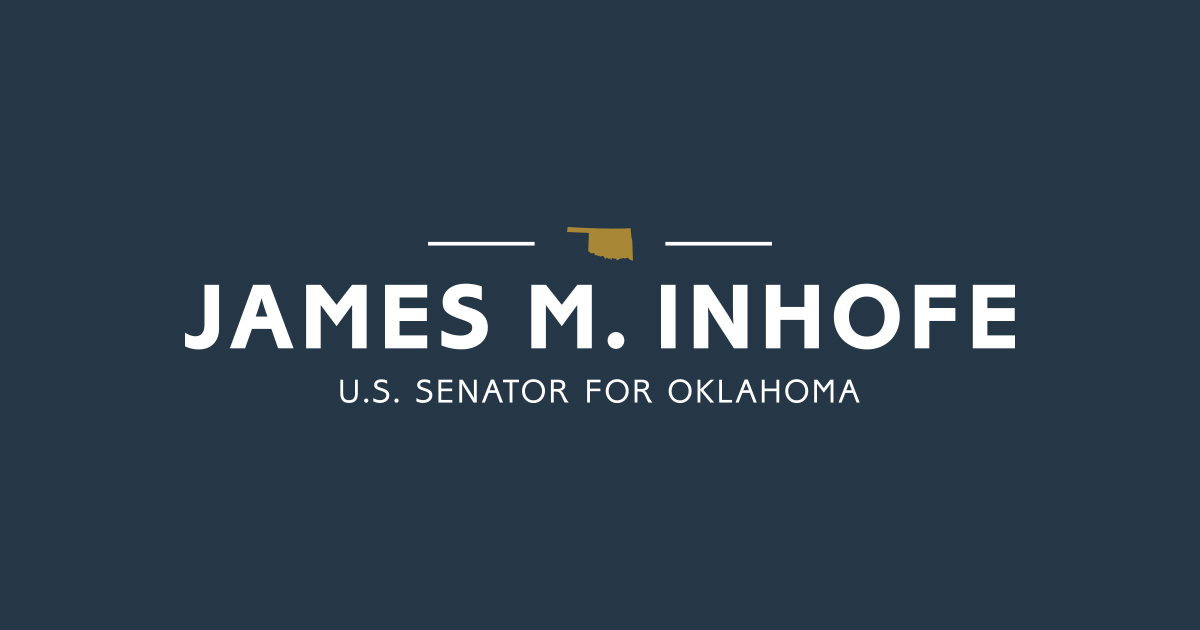Source: United States Senator for Oklahoma James Inhofe
Yesterday, U.S. Sen. Jim Inhofe (R-Okla.), senior member of the Environment and Public Works (EPW) Committee, questioned witnesses at an EPW hearing entitled: Examining the Benefits of Investing in USACE Water Infrastructure Projects.
Witnesses included: Amy Larson, Founding Partner, Larson Strategies LLC; Robert McCoy, President and CEO, Amherst Madison Inc. (on behalf of Waterways Council, Inc.); Mario Cordero, Executive Director, Port of Long Beach, California (on behalf of the American Association of Port Authorities); and Collin O’Mara, CEO, National Wildlife Federation.
Inhofe: All right. Well, thank you. Thank you. I say to my friend, Senator Whitehouse, that it’s loud and clear. We’ve heard this. First of all, let me thank you for the respect that you paid to our fallen brother, Mike Enzi, last night by staying there and observing a tribute to him.
Whitehouse: You gave a great tribute, and I was pleased to be there.
Inhofe: Thank you very much. Now, obviously, we are inland. We are concerned, and I think that we’ve been complimentary in the past at the equal treatment I have felt has been given. But in the WRDA 2020; I was chairman of the committee at that time, and I was able to include the authorization for the Tulsa-West Tulsa Levee System, and we had a devastating flood at that time; I think everyone in the country was aware that it’s an old levee. You’re talking about something, one of the witnesses talking about something that was 50 years old. That levee is 80 years old, and it’s far beyond its useful life. I think we are going to be getting some action. Ms. Larson, in your testimony, you note that consideration for life, safety should be paramount when evaluating the benefits of flood risk projects. Ms. Larson, how can the Corp take a more expansive view on the benefits of flood risk projects, such as what they did in that Tulsa levee? I really think we could be used as a model for the successes that we had at that time, and any comments about that?
Larson: So, the Chief’s report was successful there because they got an exemption to the standard requirement to pick the NED project. That was based on life safety risks; comparing the life safety risk versus the NED. I would suggest that that should not be require an exemption. That should be one of those selections that’s available so that you don’t have to go through what sometimes is a cumbersome process to get that exemption. A challenge going forward, I see, is that OMB is loath to fund or give new start status to those projects that aren’t at the NED level. I think a lot of advocacy continues to be needed to move forward and hopefully that will serve as a model going forward that in a community that is protected there, that could be better protected because of the degraded levees that you need to look at the life safety, what’s being protected: the people, the industry utilities that are behind that levee, and take a look at that; use that life- safety metrics. I would say this will require a complex and deliberative approach. The underlying planning documents that I used to tell NWC members I read so they didn’t have to, are close to 1,000 pages. They are a bit mind-numbing. They look at, you know, how do you measure navigation projects through transportation cost savings? How do you look at urban flooding projects? What is the protection to, say, land use? This will require a long term effort to review those underlying planning documents, make sure that life safety is not an exception but is part of the rule.
Inhofe: Okay, I’m sorry, I’m running out of time here. I would suggest you just give those 10,000 pages to Senator Cramer and he’ll explain them all to us. But real quickly, I do want to get one comment in to Mr. McCoy. You know, the American Society of Civil Engineers has given the inland waterways system an overall grade of D+. Now, that kind of is a little bit revealing and somewhat inconsistent with some of the things we’ve heard. It’s clear that we need to address the aging infrastructure and critical maintenance of our nation’s inland waterways. On the MKARNS alone, we have $230 million in backlog maintenance. I’ve led delegation letters to the Corps and have submitted congressionally directed spending requests to chip away at that backlog. Mr. McCoy, what is the benefit of investing in and maintaining our inland waterways infrastructure? You know, we’re all concerned about it. We live with it on a daily basis. It happens that a frailty in that system can cost lives. It’s a very serious thing. What was your thought about where we are right now?
McCoy: The benefits, sir, in investing in infrastructure is two-fold. You create a resilient system that is more reliable. It creates jobs; it does so and promotes an industry that is environmentally responsible. It does so in a manner to reduce future ONM responsibilities with new structures or newer structures, rebuilt structures. Your operation and maintenance costs are going to be reduced. I’ve had the pleasure of visiting Murray lock and dam on the MKARNS, and I’ve seen those gentlemen from the Corps of Engineers do more with less than most other districts in the country.
Inhofe: I agree. I agree with that. That’s excellent. We will stay hooked up with you. I can’t even tell you right now what percentage of that waterway that goes through Arkansas and Oklahoma is actually a 12 foot channel as opposed to a nine foot channel because we’ve been at this thing for so long, but we’ll continue to work together as we have in the past with successes. Thank you very much.
